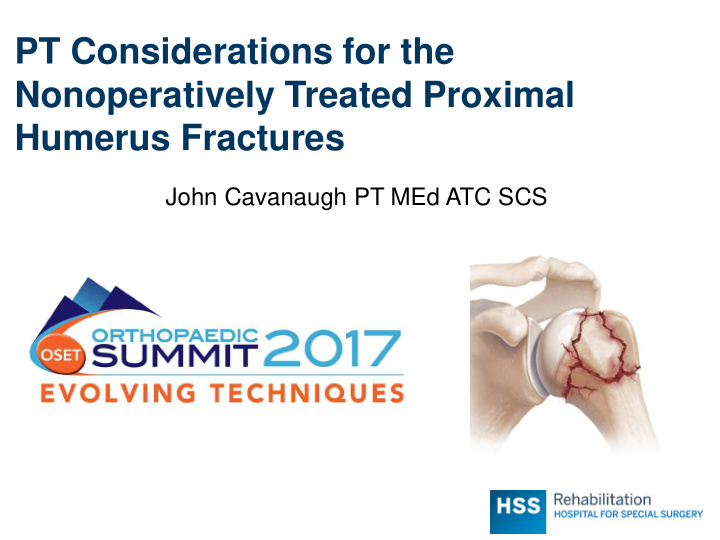



PT Considerations for the Nonoperatively Treated Proximal Humerus Fractures John Cavanaugh PT MEd ATC SCS
2
3
Proximal Humerus Fractures - Intro Incidence: 4-6% of all fractures 3rd most common fx pattern seen in elderly Injury ratio: 2:1 female to male ↑’ ed age correlates with increasing fracture risk in women Mechanism of injury: Low-energy falls elderly with osteoporotic bone High-energy trauma young individuals Concomitant soft tissue and neurovascular injuries (axillary nerve) 4
Non-Operative Management 85% PHF are minimally displaed & managed non-operatively 1, 2, 3 part surgical neck fractures Greater tuberosity fractures displaced < 5mm Good to Excellent outcomes ~85% – Koval KJ J Bone Joint Surg Am. 1997 – Gaebler C, Acta Orthop Scand. 2003 – Kruithof RN J Orthop Traumatol 2017 5
Non-Operative Management Fracture healing : Rehabilitation: 3 distinct but overlapping 3 distinct but overlapping stages phases Inflammatory stage Maximum Protection Phase Repair stage Moderate Protection Phase Late remodeling stage Return to Function Phase 6
Proximal Humerus Fracture Non-Operative Rehabilitation Guielines General Principles Phyisician directed Radiograph evidence of healing Realistic Goals Early Mobilization – Hodgson J Shld Elbow Surg 2007 – Lefevre-Colau JBJS 2007 7
Randomized, prospective/controlled trial of minimally displaced PHF Group A: (N 44) Immediate ROM Group B: (N 42) 3 weeks of immobilization Craft Shoulder Disability Questionnaire Group A 42.8% (1 year) 43.2% (2 year) Group B 72.5% (1 year) 59.5% (2 year ) – Reported 3x more pain on movement, 2x night disturbance 8
RCT: 74 patients with an impacted PHF (1,2,3 part) Group A: 37 passive mobilization within 3 days of frx Group B: 37 sling immobilization x 3 weeks Constant Global Score (3 months f/u) (A) 71 vs (B) 61.1 Mean change in pain (6 weeks →3 mo) (A) 34.9 vs (B) 19.2 Fracture-healing rate 100% (A & B) Compliance to PT sessions = 70% (A & B) 9
Proximal Humerus Fracture Non-Operative Rehabilitation Guielines General Principles Physical Therapist guided – MD directed clinical guideline Individualized Criteria based progression Communication w/MD 10
Maximum Protection Phase (0-6 weeks) Goals : Control pain and swelling Protect fracture site / Allow for healing Maintain ROM/Function distal extremity Improve AAROM: Elevation to 110 ° and ER to 30 ° Independent with home exercise program 11
Maximum Protection Phase (0-6 weeks) Treatment Interventions: Modalities (Ice / TENS ) (Moist Heat after 10 days) Sling immobilization (duration / schedule per MD) Cervical & distal extremity AROM Postural correction (as indicated) Codman’s / Pendulum execises (when tolerated) 12
Maximum Protection Phase (0-6 weeks) Treatment Interventions: PROM: Elevation / ER AAROM (when tolerated): – Elevation / ER Aquatic therapy 13
Re-education for dyssynergic shoulders Adjunct to traditional therapeutic exercise Proprioceptive input 14
Maximum Protection Phase (0-6 weeks) Treatment Interventions Scapular and Deltoid strengthening (when tolerated) Soft Tissue Massage Home exercise program – consider insurance situation 15
Maximum Protection Phase (0-6 weeks) Criteria for Advancement Tolerating sling discontinuation with self-care, ADL’s AAROM: Elevation to 110° ER to 30° 16
Moderate Protection Phase (4-12 weeks) AAROM: Wand FF/ER Pulleys (when appropriate) 120 degrees FF Humeral Head Control Active IR ROM (Towel pass) 17
Moderate Protection Phase (4-12 weeks) Glenohumeral mobilization Scapular stabilization exercises 18
Moderate Protection Phase (4-12 weeks) Airdyne Bike Upper Body Ergometer Scapular and Deltoid PRE’s 19
Moderate Protection Phase (4-12 weeks) Rototor cuff Isometrics Dictated by gains in ER ROM Scaption (PRE) 20
Moderate Protection Phase (4-12 weeks) Criteria for Advancement / Goals AAROM : Elevation to 150° ER to 65°, IR to 70° Improve scapulohumeral rhythm to WNL < 90° elevation (scapular plane) Improve muscle strength to > 4/5 Independent with home exercise program as instructed 21
Strengthening / Function Phase (10-? Weeks) Goals: Improve scapulohumeral rhythm to WNL < 120°elevation (scapular plane) Improve muscle strength to 5/5 Maximize ROM, strength, flexibility so to meet the demands of ADL and/or sports participation where indicated Independent with home exercise program as instructed 22
Strengthening / Function Phase (10-? Weeks) Treatment Interventions Towel Stretch (IR) Posterior capsule stretching Pect Minor Streching Rototor cuff Isotonics 23
Strengthening / Function Phase (10-? Weeks) Treatment Interventions PNF (Manual resistance → theraband) Sport Specific Activites (if and when indicated) – e.g. golf, tennis, etc) 24
Summary Rehabilitation Guidelines: PHF Directed by MD, Guided by PT Radiological evidence of healing Early Mobilization Criteria for advancement Succesful Outcome 25
Recommend
More recommend